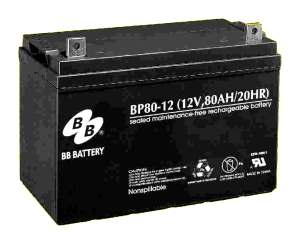|
Q: Can I use a car battery for deep cycling, for example in a
solar energy system, or for trolling?SLI (Starting, Lights, and Ignition)
batteries are optimized for high current sourcing and small discharges. They
are built with a lot of plate surface area, which allows a small battery to
source a high current. But deep discharges will deplete the plates and cause
them to shed and corrode. Here is a plot showing the
effect of deep discharges on car
battery degradation.

Q: What is the car battery charging voltage? What
voltage is required to charge it? Is a 12V power supply enough?A: A 12V
car battery can be safely charged over a range of voltages, but 12V isn't one
of them. They need at least 12.9 volts to charge, but at this voltage the
charge rate of an automobile battery is very slow. A car battery can be charged
safely at voltages higher than the gassing voltage as long as the battery is
not fully charged. Alternator voltages and battery chargers voltages can go
over 15V safely, as long as the car battery is monitored to make sure that it
isn't being overcharged. Modern high accuracy chargers automatically do this.
These higher voltages allow the battery to be charged faster. But if you want
to leave the battery on the charger to keep it topped off, a float voltage of
13.6V to 13.8V is usually used. For more information on
charging lead acid batteries look here.
Q: Why does my multimeter measure voltages higher than 12.9V on
my car battery, even when the engine is off? A: The battery is charged at
higher voltage, typically 14.4V for fast charging and 13.8V for float charging.
The battery's plates have a certain amount of capacitance, and can hold charge
like a capacitor, thus reflecting this "plate charge." There is a surprising
amount of energy stored in this way. If you let the battery sit for about 5
days without charging or discharging this charge dissipates and the true
open-circuit-voltage can be measured.
Q: What is the 12V car battery voltage range as it is charging
and discharging? A: Car battery voltage will change depending on its
condition. When the engine is off the battery open circuit voltage is 12.9
volts. A freshly charged battery, either by alternator or charger, can measure
higher voltage than that by accumulating non-chemical charge on the plates like
a capacitor, so it might have to sit for a while or be discharged a little to
get to that voltage. As the battery discharges the voltage will sag down to 10
volts or lower.

Q: Can a car battery freeze when it gets too
cold?A: When a lead acid battery is fully charged the electrolyte is
sulfuric acid with a freezing point of below -40°C. When the battery is
fully discharged all the sulfate ions are consumed and the electrolyte is
mostly pure water with a freezing point of zero degrees C. So it is not unusual
to go out to a car that has a dead battery in the mid winter and find that the
battery won't accept any charge current. It needs to warm up and melted before
it can be charged, and then it won't freeze again unless it is discharged
again.

Q: How long does it take to recharge the battery after starting
the engine?A: Not very long. This is not too hard to estimate. Typical 12
volt car batteries are rated for cold cranking amps, and the one I use has 800
CCA. So being very very conservative lets assume that it takes 800 amps to
start the car. I have three cars, 17 years old, 14 years old, and 22 years old,
they all start in less than 3 seconds, but to be conservative let's assume 10
seconds. So 10 seconds times 800 amps is 8000 amp-seconds (8000 coulombs for
you physicists) or 2.2 amp-hours. If the alternator is sourcing 80 amps, this
will be replaced in 99 seconds.
A more accurate calculation would be 200
amps for 3 seconds, which would be replaced in less than 8 seconds.
This doesn't take into account the fact that a nearly-full battery
can't accept the full 80 amps. Linden's Battery Handbook has a useful chart
that shows that a battery at near 100% charge being charged at 14.4V will
accept about 9 Amps per 100AH of battery capacity. So using the 600 Amp-second
case and an 80AH battery, the charge will return in about 83 seconds.

How low can the battery go in voltage and still start the
vehicle?If the battery stays above 11.8 volts it will generally still
start the vehicle.
Q: Why does driving short distances flatten my
battery?A: Well, it does a number on my battery. I have a 5 mile commute
to work, and in the winter I have the headlights, the seat heater, the heater
fans and pump and the rear window defroster going continuously in the morning
and in the evening. Not to mention the radio blasting. And of course the
battery is cold, in the bottom of the trunk, so it will charge slower. This
doesn't give the battery much of a chance to charge or overcharge to
de-stratify the acid with a few bubbles. In my Jaguar the windows slide down
half an inch when the door opens to avoid the top seal. When the battery
voltage gets low the car lets me know by not raising the windows back up when
the door closes. I bought a new battery last spring, and by December the
windows are giving me trouble. As the days lengthen and I don't use the
headlights as much the car battery charge eventually fills up.

Q: Should I add water to the battery before or after I charge
it?A: Add the water before you charge. The charging process will create
bubbles that help mix the acid. The charging process, even with a completely
out of control battery charger, will not consume much water during one charge.
I should also mention that modern charging systems with accurate voltage
regulations will not consume any appreciable water, and of course the sealed
batteries recycle their water, so you can't replace it.
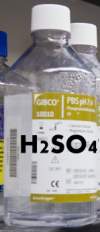
Q: What is the liquid inside a car battery?A: The battery
electrolyte is a mixture of water and sulfuric acid. The concentration of the
acid depends on the state of charge of the battery, the more discharged the
less sulfuric acid.
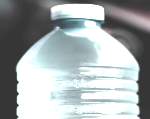
Q: Should I add battery acid or distilled water?A: The
thing that is consumed is water, so replace it with water if the water was lost
through charging and discharging. If someone dumped all the acid out of the
battery when it was fully charged, replace the acid. If they dumped out all the
acid when it was fully discharged you may be able to get away with just
replacing it with water, since the acid will be re-created during the charging
process. Of course this battery spillage problem is very rare, and you might
just want to buy a new battery.
Q: At what voltage is a car battery fully discharged?A: A
car battery can be considered to be empty when it is less than 10V. There is
very little energy available between 10V and 0V, and the battery is damaged
when discharged below 10V.
Q: Can a car battery charge another car's battery by
itself?A: A car battery does not have enough voltage to charge another
car's battery by itself. To charge the car engine must be running. To explain
further, the open circuit voltage of 12.9 volts is not enough to move the
chemistry even in a fully discharged battery. You need to be above 12.9 to
start the chemistry moving at all, and up at 13.5V to charge at a significant
rate.

Q: How much water should be in a car battery?A: There
should be an indication in the battery, as you fill up a cell the fluid will
raise to that level, then stop. Usually it is a cup with a hole in it inside
the fill port. Just fill it up until it is at the level indicated.
Q: Can a car battery recharge itself?A: This seems like an
odd question, but the answer is "sometimes." For example, you have been putting
the battery under strain, such as trying to start my old 1959 Alfa Romeo for
ten minutes until the starter wouldn't turn any more. Waiting 20 minutes will
let the reaction products diffuse away from the plates and the battery will
crank away for a while longer, which might give the impression that it
recharged itself.
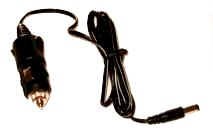
Q: What is the car cigarette lighter voltage?A: The
cigarette lighter or power point socket in a car is usually connected directly
to the battery/alternator circuit, with a fuse protecting it. So when the
engine is not running the voltage ranges between 12.9V and 10V as the battery
discharges. When the engine is running the voltage is typically between 13.6
and 14.4 volts, depending on the alternator's load curve and the state of
charge of the battery. Some cars can get up to 15V under normal operation.
Q: How much current can I draw from a car cigarette
lighter?It depends on the car. You can check on the fuse for the car
lighter to find the upper end for your particular vehicle. There is an
unofficial standard that the power point socket should supply at least 8 amps,
but many cars supply 25 to 30 amps to the socket. This will allow 300-350 watts
to be safely drawn.

Q: How much does a car battery weigh? How many amp-hours does a
car battery contain? A: The car battery's weight or mass depends on the size
of the battery, but they are typically weighing between 30 and 50 lbs, with
most approximately 41 lbs (14 kg to 22 kg). It isn't possible to reduce the
weight of a lead acid battery without also reducing the capacity, so watch out
for unscrupulous manufacturers Below are some rough estimates of battery
weights, cold cranking amps (CCA), and Amp Hour capacities of starting, light
and ignition (SLI) car batteries.
Can I relate cold cranking amps (CCA) to amp-hours
(AH)?There is a general rule that higher CCA requires higher AH, but as
you can see from the table below the relationship is hazy. Some people give a
rule of thumb of AH ~ CCA divided by 7 or 8, but the table above has a lot of
10x, 11x, even 13x. This is because batteries made to last a long time will
have more active materials.
This table was made from data sheets from
various manufacturers.
| BCI Group |
Car battery weight in lbs |
Car battery weight in kg |
Typical AH Capacity |
Typical CCA |
| 1 |
33.5 |
15 |
100 |
650 |
| 2 |
36.5 |
17 |
60 |
780 |
| 3EE |
43 |
20 |
54 |
400 |
| 4 |
47 |
21 |
125 |
975 |
| 4D |
97 |
44 |
115 |
950 |
| 7D |
60 |
27 |
156 |
950 |
| 8D |
130 |
59 |
130 |
59 |
| 24F |
40 |
18 |
55 |
650 |
| 31 |
55 |
25 |
80 |
800 |
| 22F |
30 |
13 |
35 |
425 |
| 24 |
39 |
17 |
55 |
650 |
| 25 |
31 |
14 |
45 |
600 |
| 26 |
25 |
11 |
45 |
540 |
| 27 |
67 |
30 |
92 |
900 |
| 29 |
60 |
26 |
65 |
680 |
| 35 |
31 |
14 |
45 |
600 |
| 41 |
37 |
17 |
64 |
675 |
| 42 |
29 |
13 |
40 |
475 |
| 55 |
33 |
15 |
52 |
590 |
| 56 |
33 |
15 |
52 |
585 |
| 58 |
32 |
14 |
53 |
580 |
| 62 |
33 |
15 |
52 |
590 |
| 65 |
39 |
18 |
55 |
675 |
| 75 |
35 |
16 |
60 |
700 |
| 86 |
32 |
15 |
47 |
570 |
Q: What is the car battery discharge rate?The chart above
lists maximum discharge rates at cold temperatures. The temperature is 0°F
or -17.8°C, and the criterion is that the battery be able to deliver
current at the CCA rate for 30 seconds with a voltage sag to 1.2V per cell
(7.2V for a 12V battery). The battery's internal resistance goes down 30% as it
warms from -17.8°C to 30°C, and the discharge current so a battery with
700CCA should be able to source over 900 amps for 30 seconds at 30°C. This
would be a power of around 10,000 watts. Please look at our page
Voltage Sag During Engine
Cranking for more details.

Q: What about charging a sealed car battery?A: Sealed car
batteries are the same chemistry as the flooded car batteries, but their
construction makes them less prone to water loss because any gasses can be
recombined before venting. So a sealed car battery can be charged with the same
chargers as flooded batteries, except for the ancient chargers that have poor
voltage control.
Q: What is the car battery charging current?A: A car
battery can be charged an any rate from zero to hundreds of amps. They are
designed to discharge at high current, so they can also be charged at high
current. Modern car battery chargers have high voltage precision, which makes
them safe to use at just about any current that you can afford to buy. If you
are sizing a charger for float charging, anything above 100mA should work fine.
Q: Should I disconnect a car battery before charging?A: It
isn't necessary to disconnect a battery before charging. Any drain while the
car is turned off will be minimal. The charger's voltage won't be high enough
to do any damage to the car. It is important not to remove the car's cable from
the battery terminal while the alternator is going, it could cause a voltage
spike called a "load dump" surge.
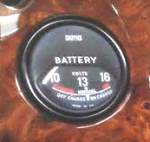
Q: How long does it take to charge a 12V car battery from
flat?A: Charging time is a function of the battery and the charger, t=
AH/A, for example if the battery needs 40AH and the charger is 10A, then
40AH/10A = 4 hours. For a battery being charged by the car's alternator it can
take an hour of driving to get it fully charged. Car batteries range from 40AH
to 110AH, and alternators range from 45 amps to 200 amps. If you are using an
alternator, a 40 amp alternator will take half an hour or less to fully charge
the battery, a 2 amp charger will take 2-4 days. Of course you don't have to
get the battery to full charge to get it to start the car, 11.8V will usually
do it.
Q: Can I use a car battery charger as a power supply?A:
Older car battery chargers can be used as power supplies, but the newer ones
have a safety feature. This prevents the charger from supplying voltage unless
it detects the presence of a battery on the leads. In other words, some minimum
voltage must be supplied externally to the leads in order for the charger to
turn on. You can see that this prevents high current sparks from the alligator
clips shorting, but it prevents you from charging a totally dead battery, and
it prevents you from using the charger as a power supply to run a car stereo in
your house, for example. For more details see "how to use a battery charger".
Q: What is a typical self-discharge rate for a car
battery?A: Any battery will eventually discharge itself. A flooded car
battery discharge rate is about 1% per day at room temperature, 0.25% per day
at 10 °C (50 °F) and 1.5% per day at 30 °C (86 °F). This self
discharge percentage is the percentage of the remaining capacity, so a flooded
lead acid battery will still have 50% of its capacity remaining after 6 months.
Low-maintenance and sealed batteries have lower discharge rates of less that
0.5% per day and calcium-lead batteries can have a self discharge of less than
2% per month.
Do you need to charge a new car battery?A: A new car
battery has plenty of charge to start and run the car, but it won't hurt the
battery to put it on a charger. If you are storing the car battery you should
put it on a float charger, or charge it every 2 months to keep it from
sulfating. |

